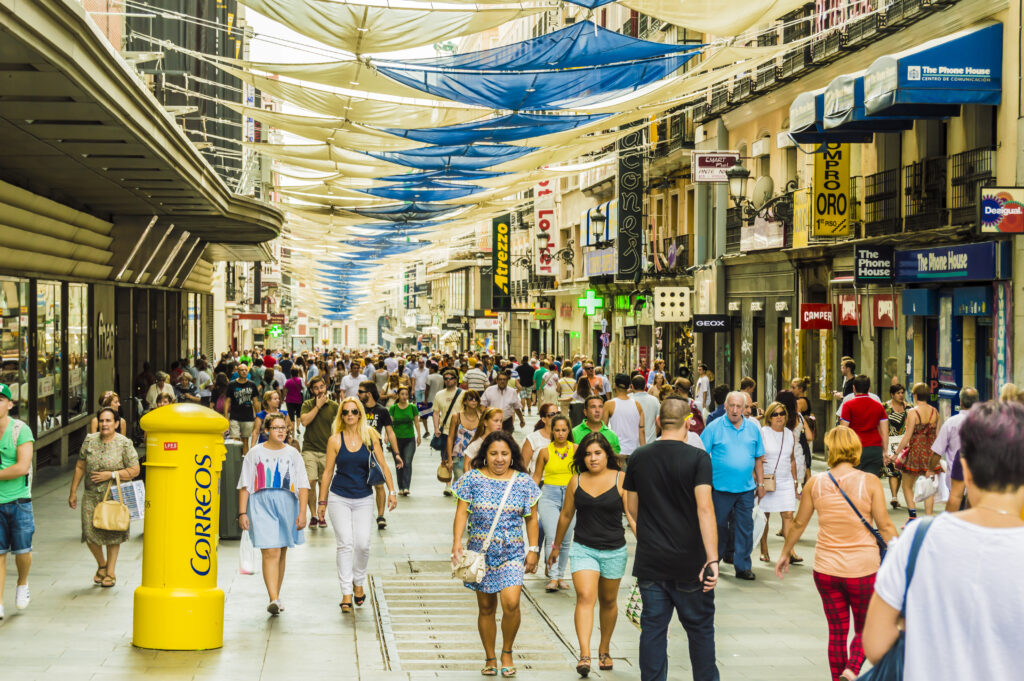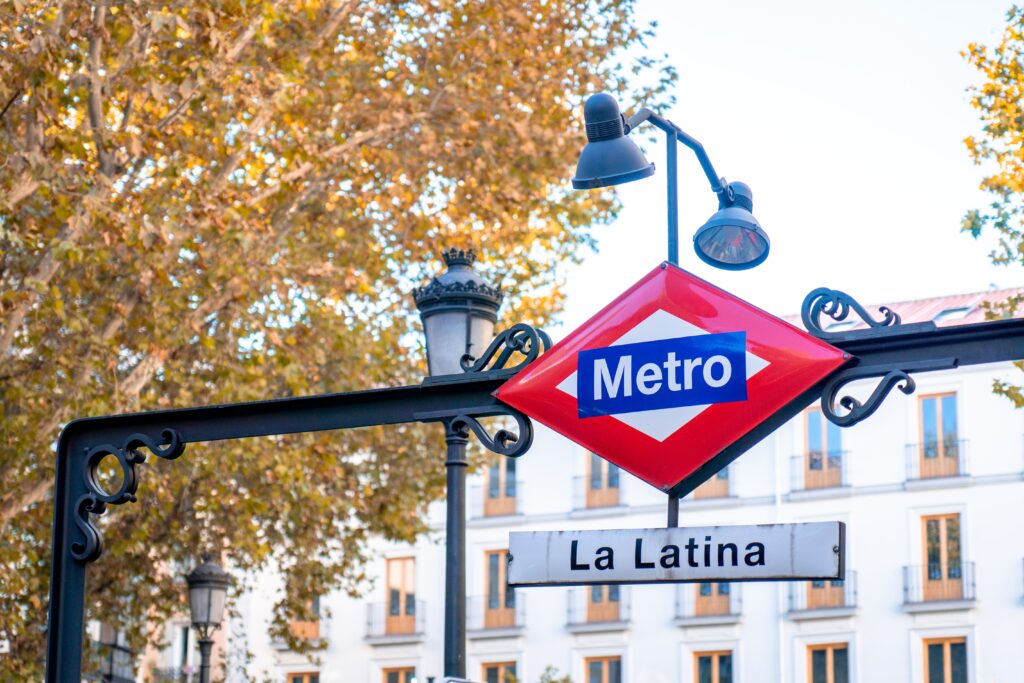
MADRID: THE LAUNCH
Madrid keeps removing vehicular access to its city center so it just keeps getting more and more walkable – in short, more family friendly. You can get to lots of the top sights and top restaurants on foot or by a short Metro ride. Walking around while eating, what more could you want from the Spanish capital? How about history and culture? This quick guide will help launch your trip. It’s the kind of information we don’t want you to spend valuable vacation time ‘figuring out.’
Get to / Get Around Madrid
¡Bienvenido a Madrid! You have all the usual options to get from the airport to the center of Madrid and beyond. Our ultimate recommendation is to take the Metro or Cercanías commuter trains into town – which one depends where exactly you’re headed (see below).
Metro: The Metro can (eventually) get you anywhere in the city. But, there are a few limiting factors. First of all, the Metro only runs from 6:00 am to 2:00 am every day. Secondly, the Metro Line 8 from the airport ends at Nuevos Ministerios which only connects to lines 6 and 10. If your targeted stop is not on lines 6 or 10 you will have to change trains again along those lines (or transfer to commuter trains at Nuevos Ministerios). Metro ticket costs depend on your destination €1.50 – €2 plus €3 for the airport leg. Rechargeable multi-ride tickets can be “passed back” or shared amongst your family.
Some general notes on Madrid’s Metro. It is safe and clean – an affordable way to get around the city. Be careful reading the Metro Map, because it is not to scale. If you only need to go 1 or 2 stops away in the city center, you might find that by the time you get down to the platform and wait for the train and then come back up, you might as well have just walked that distance. We have been comfortable negotiating the Metro with a stroller and large suitcases at the larger stations (especially the transfer hubs), but some of the smaller neighborhood stations often don’t have working escalator or elevator options.

Trains: The Cercanías commuter trains only leave from Terminal 4 (Aeropuerto T4) and run from 6:00 am to 11:00 pm. The nice thing about T4 is it’s the end of the line, so you can likely board comfortably with your gear and find seating. The train lines C-1 (less stops) and C-10 (more stops) both make stops at the most popular tourist stations: Charmartín, Nuevos Ministerios, Atocha and Principe Pio. One way ticket is €2.60 and you must use the ticket within 24 hours of purchasing it.
Keep these Cercanías commuter trains in mind. They can be a faster option than the Metro if you are traveling between larger stations (Charmartín to Atocha, for example). In fact, all Cercanías commuter trains pass through Atocha (except C-9) making it an efficient hub for getting around the city or to its outlying areas. Also, be sure to hang on to your ticket as they are often needed to enter AND exit a station.
Taxi & Uber: Taxi lines form outside each of the terminals. There is a €30 flat rate to anywhere in the city center. Make sure your driver knows that you know this. Most taxis accept credit cards for payment, but this is worth clarifying. Ride sharing app pick-ups are located in Terminal 4: Module D, level 4, parking P4. Don’t expect child car seat options for either. And, don’t expect lots of trunk space for gear. Also, you are at the mercy of el tráfico in a car.
Bus: There are city buses that stop at Barajas Airport, but we don’t recommend trying to figure that out upon arrival. Plus, they’re guaranteed to be your slowest option. The one bus you need to know about is the 24-hour Express Bus (203 Exprés Aeropuerto 203 during the day and N27 Exprés Aeropuerto during the night). It fills the gap for off hours of Metro and train and costs €5 one-way (cash only!). These yellow clad night owls will take you to Cibeles any hour of the day and Atocha during daytime only. These buses are meant for airport travelers with plenty of spots to stow luggage.

Madrid’s Dining Schedule
Madrid is one of the trickier dining schedules for a non-Spaniard to wrap his or her head around. When we say dinner is at 10:00 pm, people think we’re exaggerating. Read below so you’re prepared! Also, check out Off Hour Nibbling and The Tapas Lowdown.
Breakfast: This is not the most important meal of the day in Madrid – it’s barely a meal at all. If the local tapas spot’s front door is ajar, there’s probably coffee and the ubiquitous puff pastry napolitana de chocolate inside. This will be a no frills operation. The default café is pulled espresso, or treat yourself to a café con leche. Coffee aficionados may want to keep their eyes peeled for a coffee shop with a more bohemian or hipster vibe (where integrity of the beans matches the caliber of machine). But what to do about early risers in your crew? It is imperative you have some basics on hand in your hotel or rental home, as you can find cereal, bread, yogurt and all your usual breakfast items at the local Carrefour or DIA grocery store.
Lunch: Now this is typically the biggest meal of the day, and encompasses a significant chunk of time in the afternoon, from 2:00 pm to as late as 5:00 pm. This allows people to leave their office buildings, schools and small shops to go home (or go out) for lunch. After a satisfying lunch, there is hopefully time left for a siesta or afternoon cat nap. This is the meal period you want to devote the most foresight to. If a lunch restaurant piques your interest either walking by or in your planning, book a reservation. These lunch restaurants usually sport a sandwich board outside touting their menú del día: a starter, entree, dessert and drink all for a reasonable price.
Dinner: Dinner is late, even by American big city standards. Going out to eat dinner before 10:00 pm is possible, but you won’t be surrounded by Madrileños; you’ll see a smattering of other tourists looking around wondering if they’re in the right spot, since it’s so dead in there. We generally eat dinner in our rental apartment, and earlier than the city dictates. Turns out all those photogenic foods from the stalls at the mercado are also ingredients to tasty casa-cooked meals. This is, admittedly, a conciliatory choice, because our kids are young and generally wiped out after a big day touring. Tapas are there to round out your eating needs at any other time of day.
We have a simple restaurant rating system at EFTF. If we had a good experience at a particular restaurant, we’ll mention it in the hopes you might like it too!
What Neighborhood to Stay in?
We have two neighborhoods to consider for finding a hotel or an apartment. We like to be just below the action, in La Latina, or right above the action in Malasaña. In either of these neighborhoods, you’re never more than a minute or two walk to a plaza to hang out in.

La Latina: Some of the city’s oldest pockets exist in the winding streets of this medieval part of Madrid. With age comes tradition, and people have been descending upon this neighborhood for tapas and nightlife since anybody can remember. Sundays are especially lively as families and friends gather for brunches and long lunches after the El Rastro flea market. This barrio can provide the right blend of action and convenience. The smaller, irregular streets offer just enough reprieve from the livelier plazas they lead to.
Malasaña: Too many visitors to Madrid treat the famous Gran Via as the northern border of the city. Not true! Push past the throngs of shoppers and enter a neighborhood home to hipsters and creatives (euphemisms for the fact young people live here). You’ll find vintage clothing, record stores, book shops and coffee shops that care about sourcing and roasting. The trade off is the farther up the hill you are (keep that in mind if you have a stroller), the more of a commute you will have to the touristic city center. But, this neighborhood has chill vibes and ample opportunity to stumble upon places to hang out and/or eat.